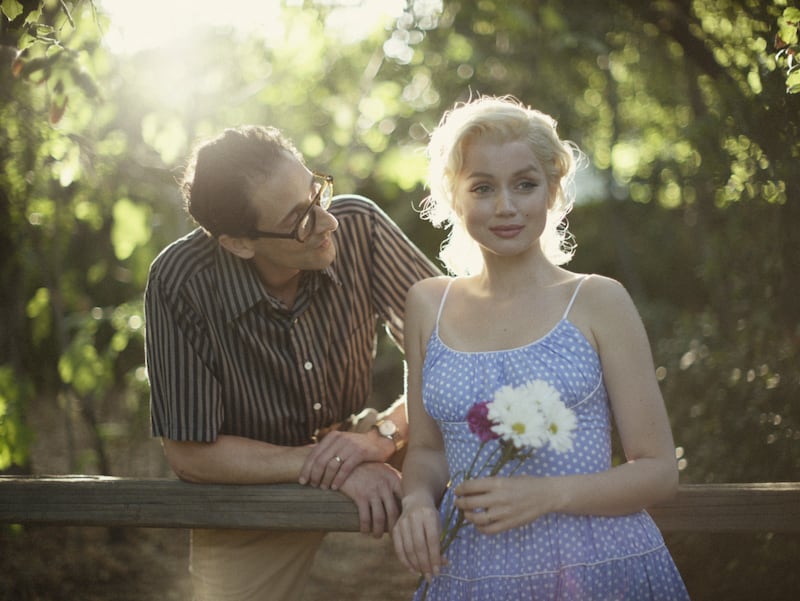One of the most chewed-over films of the aeon is finally in cinemas. Three years after the start of principal photography, Andrew Dominik’s study of Marilyn Monroe — from a “non-fiction novel” by Joyce Carol Oates — is wafted towards us on clouds of pre-release controversy. If rumours are to be believed (and they almost certainly aren’t), Netflix executives reacted to an early screening with the same aghast open mouths we saw at the interval of Springtime for Hitler. Sure enough, the film went on to secure the only NC-17 certificate — reserved for the most extreme mainstream entertainment — issued in the United States this year. At least one popular American critic has vowed not to review the thing on that basis alone.
The Motion Picture Association’s decision proves to be baffling. Awarded a mere 16 here, Blonde is certainly packed with disturbing material, but, one scene of fellatio aside, it is no more explicit than a dozen dramas currently streaming on Netflix.
Those protective of Monroe’s legacy may, however, want to issue their own stern pre-emptive caution. Blonde sets the star on a Via Dolorosa so gruelling that actual crucifixion would seem an easy release. Her mentally ill mother nearly murders her. An early producer rapes her. One husband beats her when nude photographs emerge. She is forced into having an abortion and then suffers torments as she fails to bring another pregnancy to completion. Every man takes the unsatisfactory place of the father she never knew. She sinks into drug addiction and paranoia. A final, fictional twist takes away a rare shred of comfort. Nobody could deny that Dominik layers sympathy on Monroe, but the reduction of her life to a catalogue of torments betrays the complicated, intelligent and — God forbid this were acknowledged — funny person we knew her to be. Defining her solely by misery feels like more postmortem abuse.

Ana de Armas makes a decent fist of a near-impossible task. The Cuban actor doesn’t look much like Monroe facially; her body is an entirely different shape and her accent occasionally pokes through the singsong vowels. But she has the advantage — oh boy, does the film let us know this — that “Marilyn Monroe” can be viewed as a fictional construct. In her excellent 2004 book The Many Lives of Marilyn Monroe, Sarah Churchwell noted how many commentators, when addressing her subject, enjoy the inverted commas I have just dragged out. The actor herself here speaks of “Marilyn Monroe” in the apparent third person. De Armas always seems to be striving for an unattainable persona, but, Blonde argues, that may have been how it was for the former Norma Jean Mortenson.
Pamela Anderson: ‘I felt like life was really like death for me’
Jamie Dornan: ‘I lost my mom, and I lost four of my best friends in an accident. I had a difficult few years’
From national journalism and lecturing in TU Dublin to living as a Buddhist priest
Bat conservation: Simple ways you can help these tiny mammals to thrive in your local area
As we might expect from the director of The Assassination of Jesse James by the Coward Robert Ford, the film abounds with striking images and persuasive montage. Shifting from colour to black and white, employing different aspect ratios and varying levels of saturation, Chayse Irvin’s cinematography reminds us of familiar photographs — George Barris’s shots of Marilyn on the beach for instance — as it offers jolts to an otherwise linear narrative. Less successful are the efforts to insert de Armas into genuine footage from films such as Niagara and Gentlemen Prefer Blondes.
More damaging is the monotony of tone and the unwillingness to allow a sliver of light into Monroe’s life. She was more than daddy love and baby regret. Clunky lines such as “It’s so phoney. You give birth to yourself,” add no nuance to the script’s arguments about the thinness of celebrity. The image of the protagonist heading to an orphanage with teddy bear under arm is the stuff of sentimental Victorian paintings.
There is, to sum up, scarcely more insight into the Monroe phenomenon here than there was in the four mawkish minutes of Candle in the Wind. Not worth the fuss.













